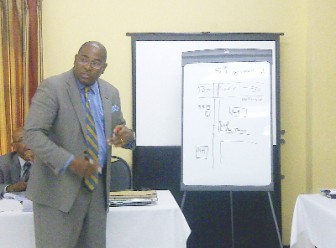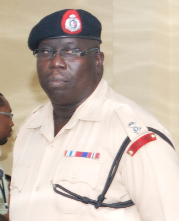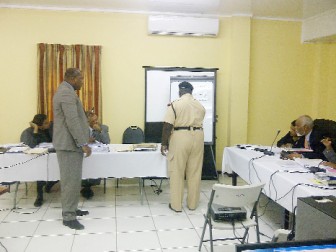ASP Patrick Todd, who fired off shotgun cartridges and tear smoke to disperse protestors from the Mackenzie-Wismar Bridge on July 18, yesterday denied harming anyone during the operation.
Resuming his testimony before the Commission of Inquiry into the fatal shooting of three Lindeners and the wounding of others on the bridge, Todd was grilled about the weapons used by the riot unit that he led, whether they followed standard operating procedures and if it was possible for them to be hit by objects thrown at them.

Attorney James Bond, one of the lawyers for main opposition APNU, questioned the Assistant Superintendent of Police (ASP) about whether he breached the operating procedures. “You used [a] shotgun prematurely… knowing it to be a weapon of deadly force. You used it to inflict grievous bodily harm to persons at the Linmine Secretariat and at the bridge,” he said.
“No, sir,” Todd, however, responded to every accusation.
On Thursday, Todd had denied ordering ranks to open fire to clear the bridge and he said that he had not seen any of them firing anything. He admitted that he was the only person to fire shotgun cartridges and discharge teargas after objects were thrown at them and they heard explosions, but said that he fired in the air and on the ground.
Todd, the officer-in-charge of the operation to clear the bridge, had been previously identified by acting Police Commissioner Leroy Brumell as the person who gave the order to shoot based on the report he had received on the incident.
Todd explained that he was not confident that the ranks who he had taken to Linden on July 18 were experienced enough to handle the weapons which were designated to them, and specifically the tear gas grenades and the shotguns.

“I felt more confident to use it because of my experience… I could have either instructed them but I realised the experience was not there,” he said in reply to a question by Bond.
Commissioner K.D. Knight inquired whether the ranks were competent enough to fire a shotgun and Todd confirmed that they were. “I wanted to use caution and prevent injury… at the time I didn’t have the confidence,” he, however, added.
Knight inquired whether the ranks are allowed to respond in the circumstance and was told they are, although the standard operating procedures do not allow them to use weapons. “The manual is just a training guide. When you are on the ground, the manual does not face the danger. As unit commander, I use my judgment call. The manual is just for guidance. If the unit goes out and comes under fire, you can’t use the manual. You use any stores (weapons) to minimise any injury inflicted,” Todd explained.
Todd also revealed that it was not the first time he had led the party of ranks and that he was also involved in their training.
“Are the selected persons, in your view, competent,” Knight asked him.
“Yes sir,” he said.
‘Deadly weapons’
As Bond continued to lead the cross-examination, Todd confirmed that he had instructed the ranks on what weapons should be taken to Linden and that these orders were based on the training he had received and from their manual.

With the unit carrying two 9mm pistols, four .38 pistols, four FN rifles and four shotguns, Bond asked why there was need for the ranks to arm themselves with such “deadly weapons.”
Todd said they were within the unit specification.
“You did not equip them with CS grenades, only weapons. No weapons to safeguard life, only deadly weapons. Why?” Bond questioned but received no answer except for Todd asking that he repeat the question.
“Did you expect to come under hostile fire?” he asked Todd, who again asked that the question be repeated.
“In your experience, those 100 march processions you said you dealt with in your evidence yesterday (Thursday), were you ever shot at with rifles, 9mms, shotguns?”
Todd responded: “What is the question you are asking?”
Bond asked why he failed to equip every rank with 2 CS grenades and Todd said he carried an adequate amount of arms to quell the situation.
“The manual says that when tear smoke is laid it must be laid in sufficient quantity before any use of shotgun or other force. You must lay sufficient tear smoke. Was that done?” the attorney asked, getting an affirmative answer.
“Do you consider two shots of tear smoke sufficient? Did you say you fired one 1.5 cartridge tear smoke in the direction of the crowd? Did you say you took a hand grenade and throw in direction of Linmine…? The order is CP riot gun, then grenade smoke then the shotgun. Isn’t that the sequence?” Bond asked.
“Yes sir” Todd replied.
Knight asked whether the directions to use teargas apply to every situation and Bond stated that generally it does. Knight then asked if it is a judgment call. “In no stretch of your vision, sir, can the manual envisage two being sufficient, sir,” Bond stated.
Attorney Nigel Hughes, who is one of the lawyers representing the interests of the slain men, suggested that ranks could not have been hit by objects thrown at them, given the lengthy distance between them and the unit.
With Todd’s aid, Hughes attempted to replicate the events of the evening of the shooting by sketching the location while Todd described both crowd and police locations.
Todd on Thursday said that he and ranks approached the crowd in a line formation about 150 meters away when they came under attack by protestors. “Missiles were coming from all directions… from west and north,” Todd said before being asked by Hughes if he agreed that it is impossible to throw any object, such as a rock or stone, from 150 meters away.
Appearing to have been dumbfounded by the question, Todd did not deliver a response.
“You said missiles were coming from west and north. I am dealing with the west and yesterday (Thursday) you said the crowd was about 150 meters away,” Hughes said.
Attorney Peter Hugh, who is representing the police force at the proceedings, reminded the commissioners that the demonstration could not provide an accurate scale, particularly as it regards distance.
Todd, who said he was hit to the head by an object, was also asked whether he went to the hospital. He said no and when asked whether any other rank went for medical treatment, he said he would not be able to speak for them.
Meanwhile, Selwyn Pieters, a Barrister and Solicitor, during brief questioning sought to confirm whether the shift worked by ranks on the day of the shooting was stressful. Todd agreed, noting that the normal working hours as a policeman is eight hours and sometimes 12 hours. However, Todd noted that on July 18, ranks were on standby and were able to rest during intervals.





